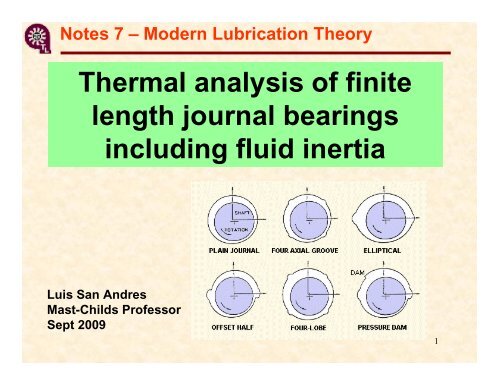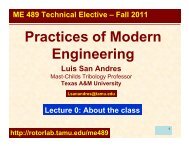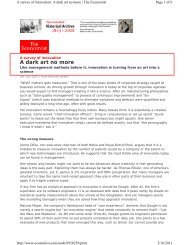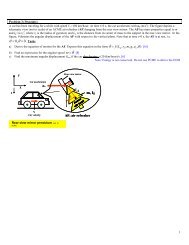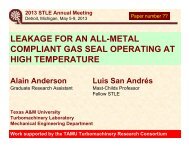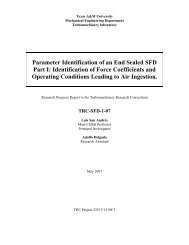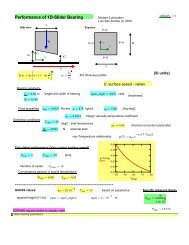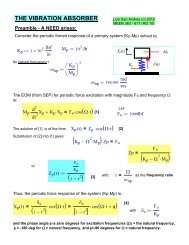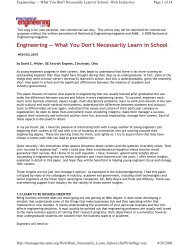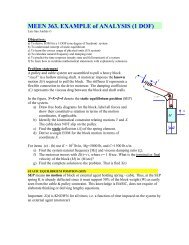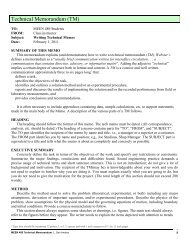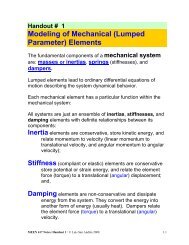Thermal analysis of finite length journal bearings including fluid inertia
Thermal analysis of finite length journal bearings including fluid inertia
Thermal analysis of finite length journal bearings including fluid inertia
Create successful ePaper yourself
Turn your PDF publications into a flip-book with our unique Google optimized e-Paper software.
Notes 7 – Modern Lubrication Theory<br />
<strong>Thermal</strong> <strong>analysis</strong> <strong>of</strong> <strong>finite</strong><br />
<strong>length</strong> <strong>journal</strong> <strong>bearings</strong><br />
<strong>including</strong> <strong>fluid</strong> <strong>inertia</strong><br />
Luis San Andres<br />
Mast-Childs Pr<strong>of</strong>essor<br />
Sept 2009<br />
1
NOTES 7<br />
THERMAL ANALYSIS OF FINITE LENGTH JOURNAL BEARINGS<br />
INCLUDING FLUID INERTIA EFFECTS<br />
Notes 4 and 5 presented the derivation <strong>of</strong> the pressure field, load capacity and dynamic force<br />
coefficients in a short <strong>length</strong> cylindrical <strong>journal</strong> bearing. Notes 7 present an <strong>analysis</strong> for the<br />
prediction, using numerical methods, <strong>of</strong> the static load capacity and dynamic force coefficients in<br />
<strong>finite</strong>-<strong>length</strong> <strong>journal</strong> <strong>bearings</strong>. Practical bearing geometries include lubricant feeding<br />
arrangements (grooves and holes), multiple pads with mechanical preloads to enhance their load<br />
capacity and stability. The <strong>analysis</strong> includes the evaluation <strong>of</strong> the film mean temperature field<br />
from an energy transport equation. The film temperature affects the viscosity <strong>of</strong> the lubricant<br />
within the <strong>fluid</strong> flow region. In addition, the <strong>analysis</strong> includes temporal <strong>fluid</strong> <strong>inertia</strong> effects<br />
modifying the classical Reynolds equation; and hence, the model predicts not only stiffness and<br />
damping force coefficients but also added mass coefficients. As recent test data shows, <strong>fluid</strong><br />
<strong>inertia</strong> effects cannot longer be ignored in <strong>journal</strong> bearing forced performance, static or dynamic.<br />
Introduction<br />
Analysis <strong>of</strong> the dynamic performance <strong>of</strong> rotors supported on <strong>fluid</strong> film <strong>bearings</strong> relies not just<br />
on the rotor structural (mass and elastic) properties but also on the acurate evaluation <strong>of</strong> the static<br />
and dynamic forced performance characteristics <strong>of</strong> the bearing supports. A rotordynamic <strong>analysis</strong><br />
delivers synchronous response to imbalance and stability results in accordance with API<br />
requirements, to demonstrate certain performance characteristics ; and on occasion, to reproduce<br />
peculiar field phenomena and to troubleshoot malfunctions or limitations <strong>of</strong> the operating<br />
system.<br />
Mineral-oil lubricated <strong>bearings</strong> support most commercial machinery that operate at low to<br />
moderately high rotational shaft speeds. The <strong>bearings</strong> carry heavy static loads, mainly a fraction<br />
<strong>of</strong> the rotor weight. The lubricant, supplied from an external reservoir, fills the small clearance<br />
separating the shaft (<strong>journal</strong>) from the bearing. Shaft rotation drags the lubricant through the<br />
bearing film lands to form the hydrodynamic wedge that generates the hydrodynamic <strong>fluid</strong> film<br />
pressure that, acting on the <strong>journal</strong>, is able to support or carry the applied static load. The mineral<br />
oil lubricant, generally <strong>of</strong> large viscosity, increases its temperature as it carries away the<br />
Notes 7. THERMAL ANALYSIS OF FINITE LENGTH JOURNAL BEARINGS. Dr. Luis San Andrés © 2009 1
mechanical energy dissipated into heat. Hence, the material visosity <strong>of</strong> the lubricant, a strong<br />
function <strong>of</strong> temperature, does not remain constant within the film flow region in the bearing.<br />
Importantly enough, the conditions <strong>of</strong> low speed (Ω), small clarance (c), and large viscosity<br />
(μ/ρ) determine a laminar flow condition in the bearing, i.e. operation with small Reynolds<br />
numbers Re < 1,000 (Re=ρΩRc/μ). Hence, Reynolds equation <strong>of</strong> Classical Lubrication is valid<br />
for prediction <strong>of</strong> the equilibrium hydrodynamic film pressure in the bearing. The prediction <strong>of</strong><br />
the thermal energy transport in a thin film bearing is more difficult since there is a significant<br />
temperature along and accross the film, i.e. a three-dimensional phenomenon. Most importantly,<br />
the thermal energy exchange does not just involve the mechanical energy generated by shear and<br />
its advection by the lubricant flow but also must account for the heat conduction into or from the<br />
shaft and bearing cartridge.<br />
A comprehensive 3-D thermohydrodynamic <strong>analysis</strong> for prediction <strong>of</strong> performance in <strong>finite</strong><br />
<strong>length</strong> <strong>journal</strong> <strong>bearings</strong> is out <strong>of</strong> the scope <strong>of</strong> these lecture notes. The interested reader should<br />
refer to relevant work in the archival literature [1,2] for further details. However, note that most<br />
<strong>fluid</strong> film bearing designers and bearing manufacturers rarely rely on cumbersome and<br />
computationally expensive <strong>analysis</strong> tools; in particular when these require <strong>of</strong> boundary<br />
conditions that are operating system dependent (not general). More than <strong>of</strong>ten, engineers prefer<br />
to obtain model results that are in agreement with published test data and go along with their vast<br />
practical experience.<br />
Notes 7. THERMAL ANALYSIS OF FINITE LENGTH JOURNAL BEARINGS. Dr. Luis San Andrés © 2009 2
Analysis<br />
Figures 1 and 2 depict the geometry <strong>of</strong> typical cylindrical <strong>journal</strong> <strong>bearings</strong> comprised <strong>of</strong> a<br />
<strong>journal</strong> rotating with angular speed (Ω) and a bearing with one or more arcuate pads. A film <strong>of</strong><br />
lubricant fills the gap between the bearing and its <strong>journal</strong>. Journal center dislacements (e X , e Y )<br />
refer to the (X,Y) <strong>inertia</strong>l coordinate system. The angle Θ, whose origin is at the –X axis, aids to<br />
describe the film geometry. The graphs show the relevant nomenclature for <strong>analysis</strong>.<br />
Oil supply hole<br />
Y<br />
Definitions:<br />
X,Y: fixed (<strong>inertia</strong>l) coordinate system<br />
g : direction <strong>of</strong> gravity<br />
Circumferential (angular) coordinate<br />
Y<br />
Fluid film<br />
Casing<br />
<br />
0º -180º<br />
<br />
180º<br />
X<br />
Journal<br />
Z<br />
D<br />
g<br />
<strong>journal</strong> rotation<br />
L<br />
Z : axial coordinate<br />
L : axial <strong>length</strong> <strong>of</strong> bearing<br />
D: shaft diameter<br />
Figure 1. Geometry <strong>of</strong> a cylindrical bearing pad with feed hole (not to scale)<br />
Axial<br />
groove<br />
0º<br />
<br />
Y<br />
-90º<br />
X<br />
r P ,<br />
preload<br />
-180º<br />
0º<br />
r P ,<br />
preload<br />
Cmin=C-r P<br />
<br />
Y<br />
Axial<br />
groove<br />
-180º<br />
Cmin=C-r P<br />
X<br />
<br />
<strong>journal</strong> rotation<br />
<br />
Journal rotation<br />
Figure 2. Geometry <strong>of</strong> elliptical (two groove) and four-pad cylindrical <strong>bearings</strong> (not to<br />
scale)<br />
Notes 7. THERMAL ANALYSIS OF FINITE LENGTH JOURNAL BEARINGS. Dr. Luis San Andrés © 2009 3
Figure 3 shows a typical bearing pad with radial clearance (c) and preload (r p ) at angle Θ P . Θ l<br />
and Θ t denote the leading edge and trailing edges <strong>of</strong> the pad, respectively. Within the flow region<br />
<br />
<br />
l t,0 z L , the film thickness (h) is<br />
hcrp cos( p ) eX<br />
t<br />
cos eY<br />
t<br />
sin (1)<br />
where eX,<br />
eY <br />
are the <strong>journal</strong> center eccentricity components along the (X, Y) directions.<br />
t<br />
Nomenclature<br />
c: pad clearance<br />
Y<br />
c m : assembled clearance<br />
e : <strong>journal</strong> eccentricity<br />
r p =c-c m : preload,<br />
Bearing center<br />
Pad center<br />
r p =0, cylindrical pad<br />
r p =c, <strong>journal</strong> and pad<br />
contact<br />
<br />
r p<br />
X<br />
l <br />
p t<br />
e<br />
<strong>journal</strong><br />
Film thickness:<br />
h c e cos e sin r<br />
cos( <br />
<br />
)<br />
X Y p p<br />
Pad with<br />
preload<br />
Figure 3. Geometry <strong>of</strong> a bearing pad with preload and description <strong>of</strong> film thickness (not to<br />
scale)<br />
Governing equations for pressure generation and temperature transport<br />
The modified [3,4,5] laminar flow Reynolds equation describing the generation <strong>of</strong><br />
hydrodynamic pressure (P) in the thin film region l t,0 z L <strong>of</strong> a bearing pad is<br />
1 <br />
<br />
R 12 z 12 z t 2 12<br />
<br />
t<br />
3 3 2 2<br />
h P h P h h h h<br />
2 2<br />
( T) ( T) ( T)<br />
(2)<br />
Notes 7. THERMAL ANALYSIS OF FINITE LENGTH JOURNAL BEARINGS. Dr. Luis San Andrés © 2009 4
Geometry for bearing pad with preload<br />
Nomenclature<br />
c: pad clearance<br />
c m : assembled clearance<br />
e : <strong>journal</strong> eccentricity<br />
r p =c-c m : preload,<br />
Bearing center<br />
Y<br />
Pad center<br />
Note: angle <br />
origin starts from<br />
-X axis<br />
r p =0, cylindrical pad<br />
r p =c, <strong>journal</strong> and pad<br />
contact<br />
Film thickness:<br />
<br />
r p<br />
X<br />
l<br />
<br />
p<br />
t<br />
e<br />
<strong>journal</strong><br />
hce cos e sin r cos( <br />
)<br />
X Y p p<br />
Pad with<br />
preload
Ask about:<br />
What is a pad preload?<br />
What is the pad <strong>of</strong>fset?
<strong>journal</strong><br />
PAD
OFFSET = 50%<br />
Positive preload<br />
Zero preload<br />
<strong>journal</strong><br />
<br />
<strong>journal</strong><br />
<br />
PAD<br />
PAD
OFFSET = 50%<br />
Positive preload<br />
negative preload<br />
<strong>journal</strong><br />
<br />
<strong>journal</strong><br />
<br />
PAD<br />
PAD
OFFSET = 50% OFFSET ~ 75 %<br />
Positive preload<br />
Positive preload<br />
<strong>journal</strong><br />
<br />
<strong>journal</strong><br />
<br />
PAD<br />
PAD
OFFSET = 50% OFFSET ~ 25 %<br />
Positive preload<br />
Positive preload<br />
<strong>journal</strong><br />
<br />
<strong>journal</strong><br />
<br />
PAD<br />
PAD
where (ρ, μ) denote the lubricant density and viscosity, both temperature (T) dependent material<br />
vT TS<br />
properties. For example, , with subindex S denoting supply conditions. The<br />
S e <br />
modified Reynolds equation includes temporal <strong>fluid</strong> <strong>inertia</strong> effects ; hence, the flow model is<br />
strictly applicable to lubricant thin film flows induced by small amplitude <strong>journal</strong> motions about<br />
an equilibrium position.<br />
For the laminar flow <strong>of</strong> an incompressible <strong>fluid</strong> and regarding the temperature as uniform<br />
along the axial direction, the energy transport equation under steady-state conditions is [6]<br />
2 2<br />
2<br />
12 <br />
2 R R<br />
<br />
Cv<br />
hUT hWT<br />
Qs<br />
S W U<br />
R z<br />
<br />
h 12 2 <br />
(3)<br />
<br />
<br />
where T is the lubricant bulk-temperature 1 and Q h T T h T T <br />
is the heat flow<br />
s B B J J<br />
into the bearing and <strong>journal</strong> surfaces. Above, C v is the lubricant specific heat, and (W, U)<br />
represent the axial and circumferential mean flow velocities given by<br />
h 2 P h 2<br />
P R<br />
W ; U <br />
12 z<br />
12 R<br />
2<br />
(4)<br />
Eq. (3) is representative <strong>of</strong> a bulk-flow model that balances the mechanical shear dissipation<br />
energy (S) to the thermal energy transport due to advection by the <strong>fluid</strong> flow and convection (Q s )<br />
into the bearing surfaces. The heat convection coefficients hB,<br />
h<br />
J<br />
depend on the Prandtl<br />
number ( P r<br />
C v<br />
) and the flow condition defined by the local Reynolds number Uh<br />
<br />
Re<br />
<br />
<br />
relative to the bearing and <strong>journal</strong> surfaces[7]. For laminar flow, c<br />
R 1, Colburn’s analogy<br />
R<br />
renders the convection coefficients<br />
1<br />
3 3<br />
<br />
h P r<br />
. See Ref. [8] for details 2 .<br />
h<br />
e<br />
1 h zy<br />
1 The bulk temperature represents an average across the film thickness, i.e. T T<br />
, , dy<br />
<br />
h<br />
<br />
0<br />
2 The THD model implements a number <strong>of</strong> heat transfer models, <strong>including</strong> those for fixed or developing wall<br />
temperatures and heat flows.<br />
Notes 7. THERMAL ANALYSIS OF FINITE LENGTH JOURNAL BEARINGS. Dr. Luis San Andrés © 2009 5
Boundary conditions for film pressure and temperature 3<br />
The pressure at a pad leading edge equals a supply condition, i.e.<br />
The pressure is ambient at the bearing axial ends,<br />
and also at the pad trailing edge,<br />
l<br />
<br />
<br />
0 zL: P , z P<br />
(5a)<br />
l<br />
,0 P ; P,<br />
L P ;<br />
t<br />
: P<br />
a<br />
a<br />
S<br />
<br />
(5b)<br />
<br />
<br />
0 zL: P , z P<br />
(5c)<br />
t<br />
Furthermore, within the whole flow domain, P > P cav , i.e., the film pressure must be higher<br />
than the lubricant cavitation pressure. For a thorough discussion on lubricant cavitation and<br />
physical sound boundary conditions refer to Notes 6 [9].<br />
Lubricant is supplied into the bearing at a known supply temperature (T S ). The <strong>fluid</strong><br />
temperature (T) gradually increases as it flows through the film thickness in a bearing pad since<br />
the lubricant removes shear induced mechanical energy. At the leading edge <strong>of</strong> a pad (Θ l ), there<br />
is mixing <strong>of</strong> the supplied cold lubricant flow rate (F S ) and a fraction <strong>of</strong> the hot lubricant flow<br />
(F up ) leaving the upstream with temperature T up . The flow and thermal energy mixing conditions,<br />
as shown in schematic form in Figure 4, are specified as<br />
L<br />
where <br />
<br />
up<br />
in<br />
0 l<br />
<br />
a<br />
F F F<br />
in S up<br />
C F T F T <br />
F T<br />
v in in S S up up<br />
F W h dz is the volumetric flow rate entering the pad at temperature T in , and<br />
L<br />
<br />
. The mixing parameter 0,1<br />
F W h dz<br />
0 t<br />
<br />
<br />
<br />
(6)<br />
is an empirical variable. Current or<br />
modern oil feed flow configurations incorporate direct impingement <strong>of</strong> the lubricant into a<br />
bearing pad, thus λ is low, to render cool lubricant temperature operation, i.e. T in ~ T S . In general,<br />
λ ~ 0.6-0.9 [10] for conventional feed arrangements with deep grooves and wide holes. In<br />
addition, note that the mixing thermal coefficient tends to increase 1<br />
with <strong>journal</strong> speed.<br />
3 In a symmetric and aligned bearing, the pressure field is symmetric about the bearing mid axial plane. Thus, only<br />
the pressure field for one-half bearing <strong>length</strong> needs be calculated, say from z= ½ L to z=L. In this case,<br />
P / z<br />
at z= ½ L.<br />
0<br />
Notes 7. THERMAL ANALYSIS OF FINITE LENGTH JOURNAL BEARINGS. Dr. Luis San Andrés © 2009 6
That is, as the operating speed increases it becomes increasingly difficult to suminister fresh or<br />
cold lubricant into the <strong>fluid</strong> film bearing.<br />
R<br />
F up<br />
T up<br />
Upstream pad<br />
F S<br />
T S<br />
F in<br />
T in<br />
Supply flow and<br />
temperature<br />
Downstream pad<br />
Figure 4. Schematic view <strong>of</strong> thermal mixing at the leading edge <strong>of</strong> a bearing pad (F:<br />
flow,T: temperature)<br />
Since the thermal energy transport Eq. (3) is parabolic, there is no need to specify any other<br />
temperature along the other pad boundaries. Solution <strong>of</strong> Eq. (3) determines the lubricant<br />
temperature exiting a bearing pad through its axial sides (z=0, L) and at the pad trailing edge (Θ t ).<br />
Importantly enough, in the region where the lubricant cavitates (P=P cav ), the (current) <strong>analysis</strong><br />
assumes there is no further generation <strong>of</strong> mechanical energy; and consequently, the <strong>fluid</strong><br />
temperature in this region is constant. This is not an oversimplification, as verified by predictive<br />
<strong>analysis</strong> [11] and various published measurements,see [12,13].<br />
Perturbation <strong>analysis</strong> 4<br />
Consider <strong>journal</strong> center motions <strong>of</strong> small amplitude (X, Y
Static load<br />
W<br />
o<br />
e Xo<br />
Y<br />
Y<br />
X<br />
X<br />
e o e Y<br />
Journal<br />
center<br />
<br />
clearance<br />
circle<br />
Figure 5. Depiction <strong>of</strong> small amplitude <strong>journal</strong> motions about an equilibrium position (Not<br />
to scale).<br />
The film thickness is expressed as the superposition <strong>of</strong> an equilibrium (zeroth-order)<br />
thickness (h 0 ) and a first-order thickness (h 1 ), i.e.<br />
hh0 h1 t<br />
,<br />
h0 cr cos( ) e cose<br />
sin , (8)<br />
p p X Y<br />
h X<br />
,<br />
t<br />
cos Ysin<br />
<br />
1 t<br />
0 0<br />
with<br />
h<br />
<br />
h<br />
sin( ) sin cos ; sin cos<br />
0 0<br />
<br />
0 1<br />
rp p eX eY X() t Y()<br />
t<br />
2<br />
h<br />
h<br />
X cosY sin , X cosY sin <br />
(9)<br />
2<br />
t<br />
t<br />
The perturbation in film thickness leads naturally to a perturbation in film pressure, i.e.<br />
Notes 7. THERMAL ANALYSIS OF FINITE LENGTH JOURNAL BEARINGS. Dr. Luis San Andrés © 2009 8
P( , z, t) P0( , z) P1( , z, t),<br />
P P X P Y P X P YP XP Y<br />
1<br />
X Y X Y X Y<br />
where P 0 is the zeroth-order or equilibrium pressure field defined by eX<br />
, e Y at steady<br />
operating conditions, and ΔP 1 is the perturbed dynamic pressure field 5 .<br />
Define the linear operator<br />
<br />
<br />
0 0<br />
(10)<br />
3 3<br />
L 1 h () ()<br />
0<br />
h <br />
0<br />
()<br />
<br />
<br />
<br />
R 12 R z 12 z<br />
(11)<br />
<br />
Substitution <strong>of</strong> the pressure (P) and film thickness (h) into the modified Reynolds Eq. (2)<br />
gives the following equations for determination <strong>of</strong> the equilibrium and first order pressure fields<br />
3 3<br />
L 1 h0 P <br />
0<br />
h0 P <br />
0<br />
R<br />
h0<br />
( P0 ) <br />
2 <br />
R 12 z 12 z 2 R<br />
(12a)<br />
L<br />
L<br />
<br />
<br />
P<br />
P<br />
X<br />
Y<br />
<br />
<br />
2 2<br />
<br />
R<br />
3h0 P <br />
0 <br />
3h0 P0<br />
cos<br />
cos <br />
R<br />
2 12<br />
R<br />
<br />
z 12<br />
z<br />
<br />
2 2<br />
R<br />
3h0 P <br />
0 3h0 P0<br />
sin<br />
sin <br />
R<br />
2 12<br />
R<br />
<br />
z 12<br />
z<br />
<br />
P<br />
P<br />
(12b)<br />
L cos ; L sin<br />
<br />
(12c)<br />
X<br />
Y<br />
where<br />
<br />
2 2<br />
h<br />
<br />
0 h<br />
<br />
0<br />
LPX<br />
cos ; L PY<br />
sin <br />
12<br />
<br />
<br />
(12d)<br />
12<br />
<br />
<br />
h0 crpcos( p) eX cos eY<br />
sin .<br />
0 0<br />
The boundary conditions for the solution <strong>of</strong> the zeroth- and first-order pressure fields<br />
follow. Note that in those boundaries where the pressure is fixed, say at ambient condition, the<br />
perturbed pressures must vanish, i.e. a homogeneous boundary condition. Hence,<br />
P 0 ( l ,0
At the inception <strong>of</strong> the film rupture or cavitation zone ( c ), P 0 =P cav , and P 0 0 . At<br />
this location, the first-order pressure fields also vanish, i.e. P P P P P P 0.<br />
X Y X Y X Y<br />
Other physical conditions may also apply 6 .<br />
The current <strong>analysis</strong> does not consider a perturbation in the temperature field or the lubricant<br />
material properties (density and viscosity). Recall the <strong>journal</strong> motions are small in amplitude<br />
affecting little the steady-state temperature field. However, in <strong>bearings</strong> and seals operating in the<br />
turbulent flow regime, the <strong>journal</strong> motion does affect the flow condition and hence, there is the<br />
need to account for temporal variations in the <strong>fluid</strong> material viscosity and density, see Notes 10<br />
[6]<br />
Bearing reaction forces and force coefficients<br />
The hydrodynamic pressure field generated in each pad acts on the <strong>journal</strong> to generate a <strong>fluid</strong><br />
film reaction force with components F , F . Integration <strong>of</strong> the pressure fields gives<br />
F<br />
X<br />
<br />
Y<br />
Npads<br />
Npad<br />
L t<br />
FX<br />
X cos<br />
k <br />
<br />
P( , zt , ) Rd<br />
k<br />
kdz<br />
F<br />
<br />
Y k1 F<br />
<br />
Y 1<br />
sin<br />
<br />
(14)<br />
k k <br />
0 k<br />
<br />
Substitution <strong>of</strong> Eq. (10) gives for the k th pad<br />
L <br />
t<br />
1<br />
<br />
l<br />
<br />
F<br />
cos<br />
<br />
P P X P Y P X P Y P X P Y Rddz<br />
(15)<br />
X<br />
0 X Y X Y X Y<br />
F<br />
<br />
k<br />
<br />
Y k<br />
sin <br />
<br />
<br />
0 <br />
<br />
<br />
The components <strong>of</strong> a pad reaction force are expressed in terms <strong>of</strong> stiffness, damping and<br />
<strong>inertia</strong> force coefficients (K, C, M) αβ=X,Y<br />
FX()<br />
t FX<br />
<br />
0<br />
KXX KXY X CXX CXY X<br />
MXX MXY<br />
X<br />
<br />
F F K K<br />
<br />
Y C C<br />
<br />
Y M M<br />
<br />
<br />
<br />
Y<br />
(16)<br />
<br />
k<br />
YX YY YX YY YX YY <br />
k<br />
Y () t Y0<br />
k k k<br />
<br />
<br />
The bearing pad force coefficients follow from<br />
6 See for example, Zhang, Y., 1990, “Starting Pressure Boundary Conditions for Perturbed Reynolds Equation,”<br />
ASME Journal <strong>of</strong> Lubrication Technology, Vol. 112, pp. 551-556.<br />
Notes 7. THERMAL ANALYSIS OF FINITE LENGTH JOURNAL BEARINGS. Dr. Luis San Andrés © 2009 10
L <br />
KXX<br />
KXY<br />
cos<br />
<br />
<br />
K K<br />
<br />
sin <br />
<br />
<br />
YX YY k<br />
0 <br />
L <br />
0 <br />
1<br />
1<br />
0 <br />
1<br />
<br />
<br />
P P Rddz;<br />
X Y k<br />
CXX<br />
CXY<br />
cos<br />
PX PY Rd dz;<br />
C C<br />
<br />
sin<br />
<br />
<br />
k<br />
<br />
YX YY k<br />
L <br />
MXX<br />
MXY<br />
cos<br />
PX PY Rd dz;<br />
M M<br />
<br />
sin<br />
<br />
<br />
k<br />
<br />
<br />
YX YY k<br />
t<br />
<br />
t<br />
<br />
t<br />
<br />
(17)<br />
The individual pad forces and force coefficients add to render the components <strong>of</strong> reaction<br />
force and the force coefficients for the whole bearing, i.e.,<br />
Npads Npads Npads Npads<br />
; ; ; , XY , (18)<br />
F F K K C C M M<br />
k <br />
k<br />
<br />
k<br />
<br />
k<br />
<br />
k1 k1 k1 k1<br />
Calculation <strong>of</strong> the bearing static equilibrium position<br />
A <strong>fluid</strong> film bearing supports an applied load W. This load has components W , W along<br />
the (X,Y) fixed axes. At the rated operating condition W produces a static displacement <strong>of</strong> the<br />
<strong>journal</strong> center, better known as the equilibrium <strong>journal</strong> eccentricity e, with components eX<br />
, e Y .<br />
The static balance <strong>of</strong> forces is<br />
X<br />
Y<br />
0 0<br />
W F 0, W F<br />
0<br />
(19)<br />
X X Y Y<br />
Most <strong>fluid</strong> film bearing analyses predict the bearing reaction forces due to specified <strong>journal</strong><br />
center static displacements. Thus, in practice, an iterative procedure is implemented to predict<br />
the <strong>journal</strong> equilibrium position given the applied load.<br />
Let the <strong>journal</strong> operate with eccentricity e , e at the j th iteration and giving the bearing<br />
reaction force components <br />
X Y j<br />
F , F . Then, corrections e , e <br />
X Y j<br />
to the <strong>journal</strong> eccentricity<br />
X Y j<br />
that will render reaction forces converging towards the applied external load are given by the<br />
Newton-Raphson procedure<br />
Notes 7. THERMAL ANALYSIS OF FINITE LENGTH JOURNAL BEARINGS. Dr. Luis San Andrés © 2009 11
e<br />
<br />
<br />
e<br />
X<br />
j<br />
Y j<br />
<br />
<br />
<br />
K<br />
<br />
K<br />
XX<br />
YX<br />
K<br />
K<br />
XY<br />
YY<br />
<br />
<br />
<br />
1<br />
j<br />
W<br />
<br />
<br />
W<br />
X<br />
Y<br />
F<br />
F<br />
X<br />
Y<br />
j<br />
j<br />
<br />
<br />
<br />
(20a)<br />
and<br />
<br />
<br />
<br />
e<br />
e<br />
X<br />
j 1<br />
Y j1<br />
<br />
<br />
<br />
<br />
<br />
<br />
<br />
e<br />
e<br />
X<br />
j<br />
Y j<br />
<br />
<br />
<br />
<br />
e<br />
<br />
<br />
e<br />
X<br />
j<br />
Y j<br />
<br />
<br />
<br />
(20b)<br />
Aboce, the bearing pseudo or temporal stiffness coefficients (K αβ=X,Y ) are evaluated at e , e .<br />
X Y j<br />
Upon convergence, the differences in forces in Eq. (19) become negligible, i.e. (W+F) X,Y 0;<br />
and the stiffness coefficients are those <strong>of</strong> the bearing at its equilibrium position.<br />
Note that the bearing reaction forces are highly nonlinear functions <strong>of</strong> the <strong>journal</strong> position or<br />
eccentricity function; thus, convergence <strong>of</strong> the Newton-Raphson algorithm relies heavily on the<br />
closeness <strong>of</strong> the initial <strong>journal</strong> eccentricity components to the actual equilibrium eccentricity. Of<br />
course, the fact noted is common in the solution <strong>of</strong> any nonlienar system <strong>of</strong> equations.<br />
Generalization <strong>of</strong> the perturbation method<br />
Consider small amplitude harmonic <strong>journal</strong> motions e<br />
, e<br />
with whirl frequency <br />
about the equilibrium position eX<br />
, e Y . The film thickness (h) is the real part <strong>of</strong> the following<br />
expression<br />
<br />
0 0<br />
<br />
it<br />
it<br />
0 X Y 0 X,<br />
Y<br />
hh e cos e sin e h e h e ; ; i 1<br />
(21)<br />
with h 0 as the equilibrium film thickness at eX<br />
, e Y , and hX<br />
cos , hY<br />
sin<br />
. Note that,<br />
0 0<br />
i<br />
t<br />
h<br />
e h e <br />
2<br />
<br />
h<br />
0 i t h 2<br />
i<br />
t<br />
i e h e , <br />
e h e<br />
2<br />
<br />
(22)<br />
t t t<br />
The pressure field is written as the superposition <strong>of</strong> zeroth and first order fields,<br />
i t<br />
0 ; X , Y<br />
PP e P e <br />
X<br />
Y<br />
. (23)<br />
The zeroth-order (P 0 ) is the equilibrium pressure field satisfying<br />
3 3<br />
L 1 h0 P <br />
0<br />
h0 P <br />
0<br />
R<br />
h0<br />
( P0 ) <br />
2 <br />
R 12 z 12 z 2 R<br />
(24=12a)<br />
Notes 7. THERMAL ANALYSIS OF FINITE LENGTH JOURNAL BEARINGS. Dr. Luis San Andrés © 2009 12
and the first-order complex pressure fields P X , Y due to the <strong>journal</strong> center motions satisfy<br />
2 2 2<br />
0 3 0 0 3 0 0<br />
P<br />
<br />
h <br />
h <br />
<br />
h<br />
h h P h h<br />
P <br />
L i <br />
2 12 R 12 R z 12<br />
z<br />
<br />
; =X,Y<br />
<br />
<br />
<br />
or (25)<br />
2 2 2<br />
<br />
h0<br />
<br />
R<br />
3h0 P <br />
0 3h0h<br />
P<br />
<br />
0<br />
LP i<br />
h h h<br />
<br />
12 <br />
( T) R 2 12( T) R z12( T)<br />
z<br />
<br />
<br />
<br />
<br />
<br />
2<br />
h0<br />
<br />
Above<br />
<br />
12 <br />
= Re s represents a local squeeze film Reynolds number.<br />
<br />
The F X and F Y components <strong>of</strong> the <strong>fluid</strong> film bearing reaction force are<br />
L<br />
L<br />
it<br />
it<br />
<br />
0 ;<br />
0<br />
, X , Y<br />
0 <br />
0 <br />
F Ph Rd dz P e P e h Rd dz F Z e e<br />
where the components <strong>of</strong> the static (equilibrium) bearing reaction force at <strong>journal</strong> position<br />
<br />
0 0<br />
<br />
e , e are<br />
X<br />
Y<br />
L<br />
0 0 XY ,<br />
0 <br />
(26)<br />
F P h R d<br />
dz = - W ;<br />
(27)<br />
and the bearing impedances (Z ) rendering the stiffness, damping and <strong>inertia</strong> force coefficients,<br />
(K, C, M) αβ=X,Y , are evaluated from the real and imaginary parts <strong>of</strong><br />
L<br />
2<br />
<br />
<br />
; , XY<br />
,<br />
0 <br />
Z K M i C P h Rd dz<br />
(28)<br />
Numerical solution <strong>of</strong> film pressure equations: equilibrium and first-order<br />
The <strong>finite</strong> element method (FEM) is well suited for the numerical solution <strong>of</strong> elliptic type<br />
differential equations such as Reynolds Equation. Complicated geometrical domains are well<br />
represented by <strong>finite</strong> elements, hence its major advantage over other methods such as <strong>finite</strong><br />
differences. Another advantage becomes apparent later as the systems <strong>of</strong> equations for solution<br />
<strong>of</strong> the zeroth and first order pressure fields have the same (global) <strong>fluid</strong>ity matrix. This feature<br />
allows the most rapid evaluation <strong>of</strong> the bearing dynamic force coefficients.<br />
Notes 7. THERMAL ANALYSIS OF FINITE LENGTH JOURNAL BEARINGS. Dr. Luis San Andrés © 2009 13
Figure 6 depicts a flow region divided into a collection <strong>of</strong> N em four-noded isoparametric <strong>finite</strong><br />
elements. The pressure over an element ( e ) is given by a linear combination <strong>of</strong> nodal values<br />
<br />
P i<br />
<br />
n pe<br />
and bilinear shape functions 1<br />
<br />
e<br />
i<br />
npe<br />
<br />
1<br />
, i.e.<br />
npe<br />
npe<br />
e e e e e e<br />
0 i 0 , ;<br />
i<br />
i i<br />
X,<br />
Y<br />
i1 i1<br />
(29)<br />
P P P P<br />
Flow<br />
domain<br />
z<br />
e<br />
Nodal<br />
pressures<br />
q <br />
Flow rate<br />
x=R<br />
Figure 6. Depiction <strong>of</strong> general domain <strong>of</strong> flow field and <strong>finite</strong> element representation<br />
The Galerkin formulation [15] reduces the PDE (12a) for the equilibrium pressure field P 0<br />
within a <strong>finite</strong> element (Ω e ) into the algebraic system <strong>of</strong> linear equations<br />
pe<br />
e e<br />
e<br />
k P =- q + f : k P q f <br />
<br />
e e e<br />
0 G 0 0<br />
n<br />
; i,j=1,N pe (30)<br />
j1<br />
e<br />
ij 0j<br />
0 i 0 i<br />
where the coefficients <strong>of</strong> the element <strong>fluid</strong>ity matrix e<br />
k are<br />
<br />
<br />
k k dx dz<br />
<br />
<br />
<br />
e<br />
3<br />
e<br />
<br />
e e h <br />
0<br />
<br />
<br />
i j <br />
i j <br />
ij ji <br />
<br />
<br />
i,j=1,..N<br />
<br />
e 12 <br />
pe (31)<br />
<br />
( T ) x x z z<br />
<br />
<br />
<br />
<br />
and the right hand side vectors denote the shear flow effect and nodal flow rates,<br />
e<br />
e R<br />
<br />
i<br />
f0 h<br />
i<br />
0 dx dz<br />
2<br />
<br />
e x <br />
; q e<br />
e q d e<br />
0<br />
<br />
i i i=1,..N pe (32)<br />
0<br />
e<br />
<br />
<br />
with<br />
q <br />
0<br />
3<br />
0 0 0<br />
h P h R<br />
x<br />
(33)<br />
12<br />
2<br />
( T )<br />
Notes 7. THERMAL ANALYSIS OF FINITE LENGTH JOURNAL BEARINGS. Dr. Luis San Andrés © 2009 14
as the flow through the element boundary ( e ). Note above that the <strong>fluid</strong> viscosity is a function<br />
vT TS<br />
<strong>of</strong> the temperature, <br />
; thys, varying over the flow domain.<br />
S e <br />
The integrals in Eqns. (31, 32) are evaluated numerically over a master isoparametric<br />
element ( ˆ ) with normalized coordinates. Reddy and Gartling [16] explain the coordinate<br />
transformation and numerical integration procedure using Gauss-Legendre quadrature formulas.<br />
Eqns. (30) are assembled over the whole flow domain and then condensed by enforcing the<br />
corresponding boundary conditions. The resultant global set <strong>of</strong> equations is<br />
<br />
k P = Q + F (34)<br />
G 0 G G G<br />
Nem Nem Nem e<br />
G G G . The global <strong>fluid</strong>ity matrix k G<br />
e1 e1 e1<br />
e<br />
e<br />
wherek k , Q q , F f<br />
symmetric, easily decomposed into its upper and lower triangular form (Cholesky algorithm), i.e.<br />
k = L U = L L T<br />
(35)<br />
G G G G G<br />
A process <strong>of</strong> back- and forward-substitutions then renders the discrete zeroth order pressure<br />
field P :<br />
0 G<br />
Note that Q<br />
G<br />
<br />
G<br />
T<br />
0<br />
L L P = Q + F (36)<br />
G G G G<br />
0 denotes the addition <strong>of</strong> flow rates at a node. Hence the components <strong>of</strong><br />
this vector are nil at each internal node <strong>of</strong> the <strong>finite</strong> element domain.<br />
A similar procedure follows for solution <strong>of</strong> the perturbed (dynamic) pressure fields, P X and<br />
P Y , due to <strong>journal</strong> harmonic displacements e<br />
, e<br />
with whirl frequency ω. PDEs (25)<br />
become<br />
n<br />
n<br />
X<br />
Y<br />
pe<br />
pe<br />
e e e e e e<br />
kP ij f 0 ;<br />
j<br />
S P q<br />
j<br />
X , Y i,j=1,..N pe (37)<br />
i ij i<br />
j1 j1<br />
<br />
with hX<br />
cos , hY<br />
sin<br />
, i 1<br />
. Defining i<br />
<br />
, and<br />
i<br />
ix <br />
x iz , . Above, for<br />
z<br />
perturbations along the X-direction,<br />
for example.<br />
<br />
e e e e<br />
X G X X 0 G X<br />
k P = f S P q (37a)<br />
is<br />
Notes 7. THERMAL ANALYSIS OF FINITE LENGTH JOURNAL BEARINGS. Dr. Luis San Andrés © 2009 15
In Equations (37)<br />
e<br />
2 2<br />
e R<br />
<br />
e h <br />
e e<br />
<br />
<br />
ix <br />
<br />
i <br />
<br />
i<br />
2 e e 12( T )<br />
e<br />
<br />
<br />
0<br />
i<br />
, i <br />
f h dx dz h dx dz h <br />
<br />
dx dz<br />
<br />
e<br />
2<br />
3h h <br />
e<br />
dx dz<br />
<br />
e 12<br />
<br />
, i,j=1,..N (38)<br />
pe<br />
( T ) <br />
e<br />
0 <br />
S<br />
ix , jx , iz , jz , <br />
ij<br />
<br />
; q<br />
<br />
e e e<br />
<br />
i i <br />
<br />
e<br />
<br />
q q d<br />
<br />
3 2<br />
0 3 0 0<br />
h P h h P R<br />
h<br />
x<br />
12 12 2<br />
( T) ( T)<br />
The assembly process <strong>of</strong> the first order FE equations renders a <strong>fluid</strong>ity matrix identical to<br />
that for the equilibrium pressure field. Thus, the perturbed pressure fields can be calculated<br />
rapidly since the global <strong>fluid</strong>ity matrix k G<br />
procedure to find the equilibrium pressure field P , see Eq. (36).<br />
is originally obtained and decomposed in the<br />
In practice, the process does not require specification <strong>of</strong> a whirl frequency (ω) nor<br />
conducting several calculations to discern the stiffnesses from the mass coefficients.<br />
For P , P from Eqs. (12b):<br />
X<br />
Y<br />
n<br />
n<br />
0 G<br />
pe<br />
pe<br />
e e e e e e<br />
kP ij f 0 ;<br />
j<br />
S P q<br />
j<br />
X , Y<br />
i=1,..N pe (39a)<br />
i ij i<br />
j1 j1<br />
R<br />
2<br />
e<br />
e<br />
e<br />
0 <br />
f<br />
<br />
i hix<br />
, dx dz; S<br />
<br />
ij ix , jx , iz , jz , <br />
To make the global system <strong>of</strong> equations<br />
For P,<br />
P from Eqs. (12c):<br />
X<br />
Y<br />
<br />
e<br />
T<br />
<br />
n<br />
<br />
e<br />
2<br />
3h h<br />
<br />
<br />
12<br />
( T )<br />
σ σ σ 0<br />
G<br />
G G G<br />
<br />
<br />
<br />
e<br />
G G G<br />
e<br />
dx dz(39b)<br />
L L P = Q + F S P (39c)<br />
pe<br />
e e e e<br />
kP ij f q<br />
;<br />
j<br />
X,<br />
Y<br />
j1<br />
<br />
<br />
i i <br />
i=1,..N pe (40a)<br />
<br />
e<br />
e<br />
<br />
<br />
i<br />
<br />
<br />
i<br />
<br />
i=1,..N pe (40b)<br />
e<br />
<br />
f h dx dz<br />
Giving the global system <strong>of</strong> equations<br />
Notes 7. THERMAL ANALYSIS OF FINITE LENGTH JOURNAL BEARINGS. Dr. Luis San Andrés © 2009 16
For P , P from Eqs. (12c):<br />
X<br />
Y<br />
<br />
G<br />
T<br />
<br />
n<br />
L L P = Q + F (40c)<br />
G G σ G σ G<br />
pe<br />
e e e e<br />
kP ij f q<br />
;<br />
j<br />
X , Y<br />
j1<br />
Giving the system <strong>of</strong> equations<br />
<br />
i i <br />
i=1,..N pe (41a)<br />
e<br />
2<br />
e h <br />
0 e<br />
<br />
i<br />
i<br />
i=1,..N<br />
<br />
pe (41b)<br />
e 12 <br />
( T ) <br />
f h dx dz<br />
<br />
<br />
G<br />
T<br />
<br />
L L P = Q + F (41c)<br />
G G σ G σ G<br />
Solution <strong>of</strong> the system <strong>of</strong> equations for the first order fields is performed quickly with the<br />
procedure<br />
<br />
T<br />
<br />
L L X = Y<br />
G G G G<br />
L Z = Y findZ<br />
G G G G<br />
T<br />
L X Z findX<br />
G G G G<br />
which does not require inversion <strong>of</strong> matrices but only 2-N forward and backward substitutions.<br />
(42)<br />
Numerical solution <strong>of</strong> the traport equation for <strong>fluid</strong> film mean temperature<br />
The transport <strong>of</strong> energy equation (3) is <strong>of</strong> parabolic type. Hence, a control volume method<br />
with upwinding [17 ] is chosen to solve for the temperature field. Figure 7 depicts the control<br />
volume for integration <strong>of</strong> the thermal energy transport Eq. (3). Note that, in accordance with<br />
practice and measurements, the <strong>fluid</strong> bulk-temperature (T) does not vary along the bearing axial<br />
<strong>length</strong>. In the figure, {T e , T w and T n } are temperatures at the east, west and north faces <strong>of</strong> the P-<br />
control volume; while {T E , T W , T P } are nodal temperatures at the center <strong>of</strong> the control-volumes.<br />
Notes 7. THERMAL ANALYSIS OF FINITE LENGTH JOURNAL BEARINGS. Dr. Luis San Andrés © 2009 17
z=L<br />
z<br />
F w<br />
TW<br />
TN<br />
F n T n<br />
x<br />
F e<br />
Pressure<br />
Finite<br />
element<br />
TE<br />
F e –F w + F n =0<br />
Exit plane at ambient pressure<br />
TP<br />
T w T e<br />
z=½ L<br />
x=R<br />
F s =0 (W=0)<br />
Midplane (symmetry line)<br />
Figure 7. Control volumes for integration <strong>of</strong> energy transport equation (F: flow, T:<br />
temperature)<br />
Integration <strong>of</strong> the energy transport Eq. (3) over ½ axial <strong>length</strong> <strong>of</strong> the bearing (T-control<br />
volume) leads to:<br />
<br />
<br />
Cv<br />
hUT dz hWT dx S Q dzdx<br />
<br />
<br />
L e L<br />
<br />
e<br />
L<br />
<br />
(43)<br />
w<br />
zL/2<br />
s<br />
L 2 w L 2<br />
with the source (energy dissipation) term<br />
2 2<br />
2<br />
<br />
( T ) 2 R R<br />
<br />
12<br />
S W U <br />
h 12 <br />
<br />
2<br />
<br />
<br />
<br />
<br />
(44)<br />
and heat flow into the bearing and <strong>journal</strong> surfaces Q h T T h T T <br />
(45)<br />
s B B J J<br />
to<br />
Since the film temperature is regarded as constant along the axial direction, Eq. (43) reduces<br />
<br />
<br />
Cv<br />
T hU dz T hU dx T hW dx S Q dz dx<br />
<br />
<br />
L L e L<br />
e e w w n<br />
<br />
s (46)<br />
zL<br />
L 2 L 2 w L 2<br />
Notes 7. THERMAL ANALYSIS OF FINITE LENGTH JOURNAL BEARINGS. Dr. Luis San Andrés © 2009 18
Recall that the axial flow velocity is null 7 at the midplane <strong>of</strong> a bearing pad, i.e., W=0 at z=0.<br />
Define mass flow rates (F) through the control volume faces as<br />
L<br />
L 2<br />
L 2<br />
z<br />
e<br />
<br />
<br />
<br />
e<br />
F hU dz hU z,<br />
L<br />
Ne<br />
z<br />
w<br />
<br />
<br />
<br />
w<br />
F hU dz hU z,<br />
(47)<br />
e<br />
<br />
s<br />
<br />
<br />
<br />
J<br />
Ne<br />
J<br />
n<br />
F hW dx; F hW dx0<br />
w<br />
<br />
<br />
<br />
<br />
zL/2 z0<br />
w<br />
where Ne z is the number <strong>of</strong> P-<strong>finite</strong> elements along the axial direction. The source term from<br />
shear drag power is<br />
P<br />
L<br />
Ne<br />
2 2<br />
2<br />
z 12<br />
<br />
P<br />
( T ) 2 R R<br />
<br />
S S dz dx W U z x<br />
<br />
,<br />
<br />
12 2<br />
L 2<br />
J h <br />
<br />
<br />
<br />
<br />
(48a)<br />
<br />
<br />
<br />
e w n<br />
From mass flow continuity <br />
F F F<br />
0<br />
=0. Assume for simplicity that the bearing<br />
(T B ) and <strong>journal</strong> (T J ) temperatures are constant along the axial direction. An identical statement is<br />
made for the heat convection coefficients hB,<br />
h<br />
J<br />
. Then,<br />
L<br />
e<br />
<br />
P<br />
L<br />
L<br />
Q Qs dz dx TP hB hJ x hBTB hJ TJ<br />
x<br />
(48b)<br />
2 2<br />
L 2<br />
With the definitions above, the discretized algebraic form <strong>of</strong> the energy transport equation<br />
is:<br />
e e w w n n P P<br />
Cv<br />
<br />
F T F T F T <br />
S Q<br />
(49)<br />
Implementation <strong>of</strong> the upwind scheme [17] for the thermal flux transport terms gives:<br />
e e e e<br />
F T F ,0 TP<br />
F ,0<br />
<br />
T<br />
E<br />
w w w w<br />
F T F ,0 TW<br />
F ,0<br />
TP<br />
(50)<br />
n n n<br />
F T F ,0 <br />
<br />
T F ,0 T<br />
<br />
<br />
P n N<br />
1 1<br />
a a a a a a a a a<br />
2<br />
<br />
2<br />
;<br />
with ,0 ; ,0 ; ,0 ,0<br />
e<br />
J<br />
w<br />
J<br />
J<br />
7 This is because the pressure field is symmetric along the axial direction. That is, the peak pressure occurs at the<br />
axial mid-plane <strong>of</strong> the bearing<br />
Notes 7. THERMAL ANALYSIS OF FINITE LENGTH JOURNAL BEARINGS. Dr. Luis San Andrés © 2009 19
where T N is a <strong>fluid</strong> sump temperature (outside) <strong>of</strong> the bearing discharge plane8.<br />
Substitution <strong>of</strong> Eq. (50) into Eq. (49) renders the control-volume integral form <strong>of</strong> the energy<br />
transport equation<br />
a T a T a T a T S Q<br />
(51)<br />
P P<br />
p P w W e E n N JB<br />
where a e ,0 ; w ,0 ; n<br />
e<br />
C <br />
v<br />
F aw C <br />
v<br />
F an C <br />
v<br />
F<br />
,0<br />
(52a)<br />
L<br />
a a a a h h x<br />
(52c)<br />
2<br />
p e w n B J<br />
L<br />
Q h T h T x<br />
(52c)<br />
2<br />
P<br />
JB B B J J<br />
The system <strong>of</strong> equations (51) is easily solved with a simple recursive algorithm. If the<br />
w e<br />
lubricant flow is from left to right (w to e), then F 0; F 0 a e<br />
0 ; and the energy<br />
transport equation reduces to<br />
a T a T a T S Q<br />
(53)<br />
P P<br />
p P w W n N JB<br />
n<br />
If lubricant flows outward at the exit plane z= ½ L, F 0 a n<br />
0 , and the energy transport<br />
equation further reduces to<br />
where<br />
p w B J 2<br />
a T a T S Q<br />
(54)<br />
P P<br />
p P w W JB<br />
L<br />
a a h h x. This last equation, revealing the parabolic nature <strong>of</strong> the thermal<br />
energy transport, shows the film temperature increases due to shear power dissipation effects.<br />
P<br />
Note that 0<br />
QJB<br />
for adiabatic boundaries, i.e. hB<br />
hJ<br />
0<br />
, i.e. no heat flow into or from the<br />
bearing and <strong>journal</strong>.<br />
The algebratic equations for solutions <strong>of</strong> the presure and temperature fields are programmed<br />
in FORTRAN with a Graphical User Interface in MS Excel® for input <strong>of</strong> bearing data and<br />
operating conditions and output <strong>of</strong> predictions that include the bearing torque and flow rate,<br />
static <strong>journal</strong> eccentricity, dynamid force coefficients, and the pressure and temperature fields.<br />
For completeness in the description, Figure 8 depicts the relationship between a <strong>finite</strong> element<br />
for evaluation <strong>of</strong> the film pressure and the control-volume for temperature.<br />
8 F n < 0 means that flow is entering (instead <strong>of</strong> leaving) the bearing at the exit plane z = ½ L. This condition is not<br />
unusual in the zone <strong>of</strong> lubricant cavitation. However, in practice the value <strong>of</strong> sump temperature is not well known a-<br />
priori.<br />
Notes 7. THERMAL ANALYSIS OF FINITE LENGTH JOURNAL BEARINGS. Dr. Luis San Andrés © 2009 20
z=L<br />
West face<br />
F n<br />
East face<br />
Pressure<br />
Finite<br />
element<br />
hU) e | e<br />
hU) w | e<br />
hU) w | e+1<br />
z<br />
z<br />
z= ½ L<br />
x=R<br />
Pressure node<br />
TW<br />
TP<br />
TE<br />
F e –F w + F n =0<br />
Figure 8. Flow fluxes through faces <strong>of</strong> temperature-CV and relation to pressure <strong>finite</strong><br />
elements<br />
Examples<br />
Model predictions for test <strong>bearings</strong> reported in the literature were obtained. The benchmark<br />
cases included one and two grooved <strong>journal</strong> <strong>bearings</strong> 9 , see refs. [12,13]. In general, the<br />
predictions for static load performance conditions, <strong>including</strong> lubricant temperature rise, load<br />
capacity and <strong>journal</strong> eccentricity are in good agreement with the test data. Note that in the<br />
references listed, one or more parameters <strong>of</strong> importance are ommitted or not published. Hence,<br />
the model implemented best practices to obtain accurate results.<br />
Presently, model predictions for the static and dynamic load performance <strong>of</strong> a pressure dam<br />
<strong>journal</strong> bearing are compared against exhaustive test data acquired in the laboratory, Jughaiman<br />
and Childs [18]. Figure 9 shows a schematic view <strong>of</strong> the bearing configuration and coordinate<br />
9 A set <strong>of</strong> slides follows this lecture notes – The slides show details and comparisons <strong>of</strong> (current) model predictions<br />
and test data in Refs. [12,13,18]<br />
Notes 7. THERMAL ANALYSIS OF FINITE LENGTH JOURNAL BEARINGS. Dr. Luis San Andrés © 2009 21
system. Table 1 details the geometry <strong>of</strong> the pressure dam bearing, as detailed in Ref. [18]. Please<br />
note that Al-Jughaiman’s publication (<strong>including</strong> his M.s. thesis) misses details on the bearing<br />
geometry, lubricant inlet and feed conditions. Note that the pressure dam depth to clearance ratio<br />
and dam arc <strong>length</strong> relative to pad arc <strong>length</strong> follow standard best practices recommended by<br />
Nicholas and Allaire[19].<br />
W<br />
Y<br />
X<br />
<br />
e<br />
Feed hole<br />
Pad with relief<br />
groove<br />
Pad with pressure dam<br />
170 deg 130 deg<br />
<br />
Figure 9. Schematic view <strong>of</strong> pressure dam bearing with relief groove.<br />
In the experiments, ISO VG 32 lubricant fills the thin film lands <strong>of</strong> the pressure dam bearing.<br />
An air turbine drives the test rigid shaft supported on ball <strong>bearings</strong>. The test bearing floats on the<br />
rotating shaft. The tester includes a hydraulic cylinder for static loading, and stinger connections<br />
to hydraulic shakers that excite the floating test bearing. The instrumentation includes load cells<br />
attached to the shaker stingers, eddy current sensors mounted on the bearing and facing the shaft,<br />
and accelerometers attached to the bearing housing. The parameter identification method is<br />
Notes 7. THERMAL ANALYSIS OF FINITE LENGTH JOURNAL BEARINGS. Dr. Luis San Andrés © 2009 22
ased on frequency domain measurements and extracts the force coefficients from curve fits <strong>of</strong><br />
the real and imaginary parts <strong>of</strong> the test system impedances.<br />
The maximum load (W) applied equals 12 kN (2,700 lb) which gives a specific pressure<br />
(W/LD) = 13.45 bar (~ 200 psi).<br />
Table 1. Dimensions and operating conditions <strong>of</strong> pressure dam bearing with relief groove<br />
tested by Jughaiman and Childs [18]<br />
Journal diameter D 117.1 mm<br />
Bearing Length L 76.2 mm<br />
Radial clearance c 0.142 mm<br />
pad arc 170 deg<br />
Dam arc <strong>length</strong> D 130 deg<br />
width (0.75 L) L D 57.1 mm<br />
depth 0.4 mm<br />
Reilef groove width L R 19.05 mm<br />
depth 0.1 mm<br />
Lubricant ISO VG 32<br />
Density 860 kg/m3<br />
Specific Heat Cp 2000 J/kg-C<br />
<strong>Thermal</strong> conductivity 0.13 W/m-C<br />
Viscosity at 45 C 0.028 Pa.s<br />
Visc-temp coefficient 0.034 1/C<br />
Inlet oil temperature 40-55 ? C<br />
Inlet oil pressure N/A bar<br />
Load range 0.1-12 kN<br />
Speed range<br />
4,6,8,10,12 krpm<br />
Closure<br />
Sept 2009: Lecture notes not yet complete. See slide presentation attached.<br />
Nomenclature<br />
c<br />
Nominal film (pad) clearance [m]<br />
c m<br />
bearing assembled clearance [m]<br />
C v<br />
Lubricant specific heat [J/kg-K]<br />
C Bearing damping force coefficients;<br />
Ns <br />
, = X, Y m <br />
D<br />
Journal diameter [m]<br />
Notes 7. THERMAL ANALYSIS OF FINITE LENGTH JOURNAL BEARINGS. Dr. Luis San Andrés © 2009 23
e X , e Y Journal center eccentric displacements [m]<br />
F X , F Y Fluid film bearing reaction forces [N];<br />
F S , F in , F up , Mass flow rates: supply, inlet to pad and upstream pad [kg/s]<br />
h<br />
Pad film thickness, c – r P cos(- P ) + e X cos() + e Y sin() [m]<br />
h X , h Y cos(), sin()<br />
h , h Heat transfer convection coefficients [W/m-K]<br />
B<br />
J<br />
K Bearing stiffness force coefficients;<br />
N , = X, Y m <br />
L<br />
Journal bearing axial <strong>length</strong> [m]<br />
M Added mass (<strong>fluid</strong> <strong>inertia</strong>) coefficients;<br />
N , = X, Y m <br />
n pe<br />
N em<br />
Q s<br />
Number <strong>of</strong> nodes per <strong>finite</strong> element<br />
Number <strong>of</strong> elements in flow domain<br />
heat flow conducted into bearing and <strong>journal</strong> surfaces [W/m]<br />
P<br />
Film pressure [Pa]<br />
P a<br />
Ambient pressure [Pa]<br />
P cav Lubricant cavitation pressure [Pa]<br />
P S<br />
Supply pressure [Pa]<br />
P 0<br />
Zeroth-order (aquilibrium) pressure [Pa]<br />
P First-order complex pressure fields; , = X, Y [Pa/m]<br />
q <br />
Volumetric flow rate per unit <strong>length</strong> [m 2 /s]<br />
R<br />
½ D. Journal radius, [m]<br />
2<br />
<br />
Re<br />
h<br />
<br />
s . Local squeeze film Reynolds number.<br />
<br />
r p<br />
(c-c m ). Pad preload [m]<br />
S Mechanical energy dissipation per unit area [W/m 2 ]<br />
t<br />
Time [s]<br />
T<br />
Lubricant mean flow temperature [degK]<br />
T S<br />
Supply temperature [degK]<br />
U, W Lubricant bulk-flow velocities, circumferential and axial [m/s]<br />
2 2<br />
W X , W Y Components<strong>of</strong> applied static load, W WX<br />
WY<br />
(x= R, y, z) Coordinate system on plane <strong>of</strong> bearing (starts at -X)<br />
(X, Y) Inertial coordinate system<br />
2<br />
Z Impedance force coefficients; K <br />
M i C<br />
,<br />
N , = X, Y m <br />
α v<br />
Viscosity-temperature coefficient [1/K]<br />
Δe X , Δe Y Dynamic displacements <strong>of</strong> <strong>journal</strong> center [m]<br />
x R . Circumferential coordinate [rad],<br />
l , t , p Arc pad leading and trailing edges, angle <strong>of</strong> min. film thickness (<strong>of</strong>fset angle)<br />
[rad]<br />
v<br />
<br />
T TS<br />
<br />
S e <br />
. Fluid viscosity [Pa-s]<br />
e<br />
Element boundary<br />
ρ Fluid density [kg/m 3 ]<br />
<br />
Journal attitude angle with respect to static load vector []<br />
<br />
i<br />
<br />
n pe<br />
1<br />
Finite element shape functions<br />
Notes 7. THERMAL ANALYSIS OF FINITE LENGTH JOURNAL BEARINGS. Dr. Luis San Andrés © 2009 24
Rotor rotating speed,<br />
whirl frequency<br />
rad<br />
s <br />
e Finite element sub-domain<br />
Subscripts<br />
S<br />
in<br />
n,e,w,s<br />
N,W,E,S<br />
Superscripts<br />
e<br />
Supply condition<br />
Inlet to pad<br />
north, east, west and south <strong>of</strong> control volume<br />
North, east, west and south nodes<br />
element<br />
APPENDIX A. MODELS FOR HEAT CONVECTION COEFFICIENTS<br />
Reproduced from Ref.[7]<br />
The Reynolds-Colburn analogy between <strong>fluid</strong> friction and heat transfer for fully-developed<br />
flow determines the heat convection coefficients to accounting for heat flux from the <strong>fluid</strong> film<br />
into the shaft outer surface and from the film into the bearing cartridge. Over the entire<br />
laminar/turbulent boundary the Fanning friction factor f is:<br />
2/3 f<br />
Str<br />
(A.1)<br />
2<br />
where St<br />
h<br />
is the Stanton number, ρ and C v are the <strong>fluid</strong> density and specific heat, and U<br />
CU<br />
v<br />
cp<br />
<br />
is a mean flow velocity r<br />
is the Prandtl number, and and are <strong>fluid</strong> heat conduction<br />
<br />
coefficient and viscosity, respectively.<br />
From Eq. (A.1), heat convection coefficients h for laminar flow are derived from the Nusselt<br />
number;<br />
while for turbulent flow conditions<br />
where 4 area<br />
D hyd<br />
<br />
wetted perimeter<br />
is a hydraulic diameter.<br />
ch 1/3<br />
Nu 3 r<br />
<br />
(A.2)<br />
Dhydh<br />
0.8 0.4<br />
Nu 0.023Re<br />
<br />
r<br />
<br />
(A.3)<br />
Notes 7. THERMAL ANALYSIS OF FINITE LENGTH JOURNAL BEARINGS. Dr. Luis San Andrés © 2009 25
References<br />
[1] Boncompain, R., Fillon M., and Frene, J., 1986, "Analysis <strong>of</strong> <strong>Thermal</strong> Effects in<br />
Hydrodynamic Bearings", ASME Journal <strong>of</strong> Tribology, 108 (2), pp. 219-224.<br />
[2] Kucinschi, B., ., Fillon M., Pascovici, M., and Frene, J., 2000, “A Transient<br />
Thermoelastohydrodynamic Study <strong>of</strong> Steadily Loaded Plain Journal Bearings using Finite<br />
Element Method Analysis", ASME Journal <strong>of</strong> Tribology, 122, (1), pp. 219-226, 2000.<br />
[3] Reinhart, F., and Lund, J. W., 1975, "The Influence <strong>of</strong> Fluid Inertia on the Dynamic<br />
Properties <strong>of</strong> Journal Bearings." ASME J. Lubrication Technology, 97, pp 154-167.<br />
[4] Smith, D. L., 1975, “Journal Bearing Dynamic Characteristics-Effect <strong>of</strong> Inertia <strong>of</strong> Lubricant,<br />
Proc. Inst. Mech. Engrs., Paper No. 21, 179, Pt.3J, pp 37-44.<br />
[5] San Andrés, L., and Vance, J., 1987, "Effect <strong>of</strong> Fluid Inertia on Squeeze Film Damper Forces<br />
for Small Amplitude Circular Centered Motions," ASLE Transactions, 30, No. 1, pp. 69-76.<br />
[6] San Andrés, L., 2009, Modern Hydrodynamic Lubrication Theory, Notes 10:<br />
Thermohydrodynamic Bulk-Flow Model in Thin Film Lubrication, Texas A&M University,<br />
http://phn.tamu.edu/me626 [Accessed April 2009]<br />
[7] San Andrés, L., Yang, Z. and Childs, D., 1993, "<strong>Thermal</strong> Effects in Cryogenic Liquid<br />
Annular Seals, I: Theory and Approximate Solutions", ASME Journal <strong>of</strong> Tribology, 115, 2,<br />
pp. 267-276.<br />
[8] San Andrés, L., and Kerth, J., 2004, “<strong>Thermal</strong> Effects on the Performance <strong>of</strong> Floating Ring<br />
Bearings for Turbochargers”, Journal <strong>of</strong> Engineering Tribology, Special Issue on <strong>Thermal</strong><br />
Effects on Fluid Film Lubrication, IMechE Proceedings Part J, 218, pp. 437-450.<br />
[9] San Andrés, L., 2009, Modern Hydrodynamic Lubrication Theory, Notes 6: Cavitation in<br />
Liquid Film Bearings, Texas A&M University, http://phn.tamu.edu/me626 [Accessed<br />
September 2009]<br />
[10] Pinkus, O., 1990, “<strong>Thermal</strong> Aspects <strong>of</strong> Fluid Film Tribology,” ASME Press, N.Y.<br />
[11] Lund, J. W., and E.B. Arwas, 1964, “A Simultaneous Solution <strong>of</strong> the Lubrication and the<br />
Energy Equations for Turbulent Journal Bearing Films,” MTI Report N o 64-TR-31, MTI, Inc.,<br />
N.Y.<br />
[12] Ferron, J., Frene, J., and R. Boncompain, 1983, “A Study <strong>of</strong> the Thermohydrodynamic<br />
Performance <strong>of</strong> a Plain Journal Bearing Comparison between Theory and Experiments”,<br />
ASME Journal <strong>of</strong> Tribology, Vol. 105, pp. 422-428,<br />
[13] Brito, F.P., Miranda, A.S., Bouter, J., and Fillon, M., Frene, J., and R. Boncompain, 2007,<br />
“Experimental investigation on the influence <strong>of</strong> Supply temperature and Supply Pressure on<br />
the Performance <strong>of</strong> a Two-Axial Groove Hydrodynamic Journal Bearing”, ASME Journal <strong>of</strong><br />
Tribology, Vol. 129, pp. 98-105.<br />
[14] Lund, J., 1987, “Review <strong>of</strong> the Concept <strong>of</strong> Dynamic Coefficients for Fluid Film Journal<br />
Bearings,” ASME Journal <strong>of</strong> Tribology, Vol. 109, pp. 37- 41.<br />
[15] Klit, P. and Lund, J. W., 1988, “Calculation <strong>of</strong> the Dynamic Coefficients <strong>of</strong> a Journal<br />
Bearing Using a Variational Approach,” ASME Journal <strong>of</strong> Tribology, Vol. 108, pp. 421 - 425.<br />
Notes 7. THERMAL ANALYSIS OF FINITE LENGTH JOURNAL BEARINGS. Dr. Luis San Andrés © 2009 26
[16] Reddy J. N., Gartling, D. K., 2001, The Finite Element Method in Heat transfer and Fluid<br />
Dynamics, CRC Press, Florida, Chap. 2.<br />
[17] Patankar, S.V., 1980, Numerical Heat Transfer and Fluid Flow, Hemisphere Pubs, N.Y.<br />
[18] Al-Jughaiman, and Childs, D., 2007, “Static and Dynamic Characteristics for a Pressure-<br />
Dam Bearing”, ASME Paper GT2007-25577.<br />
[19] Nicholas, J., and Allaire, P., 1980, “Analysis <strong>of</strong> Step Journal Bearings-Finite Length and<br />
Stability,” ASLE Transactions, 22, pp. 197-207.<br />
Additional (numerical analyses) references<br />
The references below detail numerical analyses for hydrodynamic and hydrostatic liquid and gas<br />
<strong>bearings</strong>, rigid pads and tilting pads. Note that tilting pad <strong>bearings</strong> show frequency dependent<br />
force coefficients. The same holds true for gas <strong>bearings</strong><br />
Tilting Pad (liquid) <strong>bearings</strong><br />
San Andrés, L., "Turbulent Flow, Flexure-Pivot Hybrid Bearings for Cryogenic Applications,"<br />
ASME Journal <strong>of</strong> Tribology, Vol. 118, 1, pp. 190-200, 1996<br />
Gas <strong>bearings</strong><br />
San Andrés, L., 2006, “Hybrid Flexure Pivot-Tilting Pad Gas Bearings: Analysis and<br />
Experimental Validation,” ASME Journal <strong>of</strong> Tribology, 128, pp. 551-558.<br />
Delgado, A., L., San Andrés, and J. Justak, 2004, “Analysis <strong>of</strong> Performance and Rotordynamic<br />
Force Coefficients <strong>of</strong> Brush Seals with Reverse Rotation Ability”, ASME Paper GT 2004-<br />
53614<br />
San Andrés, L., and D. Wilde, 2001, “Finite Element Analysis <strong>of</strong> Gas Bearings for Oil-Free<br />
Turbomachinery,” Revue Européenne des Eléments Finis, 10 (6/7), pp. 769-790.<br />
Zirkelback, N., and L. San Andrés, 1999, "Effect <strong>of</strong> Frequency Excitation on the Force<br />
Coefficients <strong>of</strong> Spiral Groove Thrust Bearings and Face Gas Seals,” ASME Journal <strong>of</strong><br />
Tribology, 121(4), pp. 853-863.<br />
Foil Gas <strong>bearings</strong><br />
San Andrés, L., and Kim, T.H., “Thermohydrodynamic Analysis <strong>of</strong> Bump Type gas Foil<br />
Bearings: A Model Anchored to Test Data” GT2009-59919<br />
San Andrés, L., and Kim, T.H., 2009, “Analysis <strong>of</strong> Gas Foil Bearings Integrating FE Top Foil<br />
Models,” Tribology International, 42(2009), pp. 111-120.<br />
Kim, T.H., and L. San Andrés, 2008, “Heavily Loaded Gas Foil Bearings: a Model Anchored to<br />
Test Data,” ASME Journal <strong>of</strong> Engineering for Gas Turbines and Power, Vol. 130(1), pp.<br />
012504-1-8. (ASME Paper GT 2005-68486).<br />
Kim, T.H., and L. San Andrés, 2006, “Limits for High Speed Operation <strong>of</strong> Gas Foil Bearings,”<br />
ASME Journal <strong>of</strong> Tribology, 128, pp. 670-673<br />
San Andrés, L., 1995, "Turbulent Flow Foil Bearings for Cryogenic Applications," ASME<br />
Journal <strong>of</strong> Tribology, 117(1), pp. 185-195.<br />
Notes 7. THERMAL ANALYSIS OF FINITE LENGTH JOURNAL BEARINGS. Dr. Luis San Andrés © 2009 27
Hydrostatic/hydrodynamic liquid <strong>bearings</strong> and seals<br />
San Andrés, L., "Thermohydrodynamic Analysis <strong>of</strong> Fluid Film Bearings for Cryogenic<br />
Applications," AIAA Journal <strong>of</strong> Propulsion and Power, Vol. 11, 5, pp. 964-972, 1995.<br />
Yang, Z., San Andrés, L. and Childs, D., "<strong>Thermal</strong> Effects in Cryogenic Liquid Annular Seals,<br />
II: Numerical Solution and Results", ASME Journal <strong>of</strong> Tribology, Vol. 115, 2, pp. 277-284,<br />
1993 (ASME Paper 92-TRIB-5).<br />
San Andrés, L., Yang, Z. and Childs, D., "<strong>Thermal</strong> Effects in Cryogenic Liquid Annular Seals, I:<br />
Theory and Approximate Solutions", ASME Journal <strong>of</strong> Tribology, Vol. 115, 2, pp. 267-276,<br />
1993 (ASME Paper 92-TRIB-4).<br />
San Andrés, L., "Analysis <strong>of</strong> Turbulent Hydrostatic Bearings with a Barotropic Fluid," ASME<br />
Journal <strong>of</strong> Tribology, Vol. 114, 4,pp. 755-765,1992.<br />
San Andrés, L., "Fluid Compressibility Effects on the Dynamic Response <strong>of</strong> Hydrostatic Journal<br />
Bearings," WEAR, Vol. 146, pp. 269-283, 1991<br />
San Andrés, L., "Turbulent Hybrid Bearings with Fluid Inertia Effects", ASME Journal <strong>of</strong><br />
Tribology, Vol. 112, pp. 699-707,<br />
Notes 7. THERMAL ANALYSIS OF FINITE LENGTH JOURNAL BEARINGS. Dr. Luis San Andrés © 2009 28
Computational code<br />
Fortran code : complete – <strong>including</strong> prediction <strong>of</strong> <strong>inertia</strong> force<br />
coefficients<br />
GUI (Excel interface) –complete<br />
Examples for calibration:<br />
(pressure and temperature fields)<br />
oil 360 deg <strong>journal</strong> bearing<br />
Dowson et al. (1966)<br />
Ferron, Frene, Boncompain (1983)<br />
Costa, Fillon (2000 2003)<br />
oil two groove <strong>journal</strong> bearing<br />
Costa, Fillon (2000 2003)<br />
Brito, Fillon (2006, 2007)<br />
Pressure dam bearing<br />
Childs et al (2007, 2008)<br />
Load capacity & force<br />
coefficients<br />
19
Example 1 : Ferron bearing (1983)<br />
Journal diameter D 100 mm<br />
Bearing Length L 80 mm<br />
Radial clearance c 0.152 mm<br />
Groove width<br />
mm<br />
groove arc <strong>length</strong> 18 deg<br />
Lubricant<br />
Density 860 kg/m3<br />
Specific Heat Cp 2000 J/kg-C<br />
<strong>Thermal</strong> conductivity 0.13 W/m-C<br />
Viscosity at 40 C 0.0277 Pa.s<br />
Visc-temp coefficient 0.034 1/C<br />
Inlet oil temperature 40 C<br />
Inlet oil pressure 0.7 bar<br />
Load range<br />
1kN-10 kN<br />
Speed range<br />
1-4 kRPM<br />
Prandtl No 426<br />
Load No 23.98<br />
Diffusivity<br />
7.55814E-08 m2/s<br />
Ferron,J., Frene, J., and R.<br />
Boncompain, 1983, “A Study<br />
<strong>of</strong> the Thermohydrodynamic<br />
Performance <strong>of</strong> a Plain<br />
Journal Bearing Comparison<br />
Between Theory and<br />
Experiments”, ASME<br />
Journal <strong>of</strong> Tribology, Vol.<br />
105, pp. 422-428,<br />
flow<br />
<br />
W<br />
Y<br />
X<br />
Sommerfeld #<br />
S<br />
<br />
<br />
N L D<br />
W<br />
<br />
<br />
<br />
R<br />
C<br />
2<br />
<br />
<br />
<br />
20
Ferron et al. bearing (1983)<br />
Load<br />
Test data<br />
50<br />
Film temperature<br />
temperature<br />
Temperature (deg C)<br />
48<br />
46<br />
44<br />
42<br />
40<br />
0 30 60 90 120 150 180 210 240 270 300 330 360<br />
*<br />
angle (deg)<br />
2<br />
Midplane pressure pressure<br />
Pressure (MPa)<br />
1.5<br />
1<br />
0.5<br />
0<br />
0 30 60 90 120 150 180 210 240 270 300 330 360<br />
*<br />
angle (deg)<br />
p<br />
*<br />
Pressure and temperature fields – 4 kRPM, 6 kN<br />
21
Ferron et al. bearing (1983)<br />
Load<br />
Test data<br />
eccentricity ratio<br />
0.9<br />
0.8<br />
0.7<br />
0.6<br />
0.5<br />
0.4<br />
0.3<br />
0.2<br />
2000<br />
3000<br />
4000<br />
RPM<br />
0.1<br />
Eccentricity ratio (e/c) vs Sommerfeld #<br />
0.0<br />
0.0 0.1 0.2 0.3 0.4 0.5 0.6 0.7 0.8 0.9<br />
2<br />
N L D R <br />
2<br />
Sommerfeld # S <br />
W NLD C R<br />
S<br />
<br />
<br />
W C<br />
22
Ferron et al. bearing (1983)<br />
Load<br />
Test data<br />
0.9<br />
0.8<br />
eccentricity ratio (e/c)<br />
0.7<br />
0.6<br />
0.5<br />
0.4<br />
0.3<br />
0.2<br />
2 krpm<br />
0.1<br />
3 krpm kRPM<br />
4 krpm<br />
0.0<br />
0.0 2.0 4.0 6.0 8.0 10.0 12.0<br />
Load (kN)<br />
Journal eccentricity (e/c) vs. applied static load<br />
23
Ferron et al. bearing (1983)<br />
Load<br />
Test data<br />
45<br />
40<br />
35<br />
2000<br />
3000<br />
4000<br />
RPM<br />
Peak pressure<br />
30<br />
25<br />
20<br />
15<br />
10<br />
5<br />
0<br />
0.0 0.1 0.2 0.3 0.4 0.5 0.6 0.7 0.8 0.9<br />
eccentricity ratio<br />
Peak film pressure vs. eccentricity ratio (e/c)<br />
24
Ferron et al. bearing (1983)<br />
Load<br />
14<br />
12<br />
deg C<br />
Test data<br />
Peak temperature rise<br />
10<br />
8<br />
6<br />
4<br />
2<br />
Tsupply=40 C<br />
2000<br />
3000<br />
4000 RPM<br />
0<br />
0.0 0.1 0.2 0.3 0.4 0.5 0.6 0.7 0.8 0.9<br />
eccentricity ratio<br />
Peak film temperature vs. eccentricity ratio (e/c)<br />
25
Example 2: two axial groove bearing<br />
Journal diameter D 100 mm<br />
Bearing Length L 80 mm<br />
Radial clearance c 0.085 mm<br />
preload r p 0 mm<br />
Feed groove width 70 mm<br />
Pad arc <strong>length</strong> 162 deg<br />
Lubricant<br />
Density 870 kg/m3<br />
Specific Heat Cp 2000 J/kg-C<br />
<strong>Thermal</strong> conductivity 0.13 W/m-C<br />
Viscosity at 40 C 0.0293 Pa.s<br />
Visc-temp coefficient 0.032 1/C<br />
Inlet oil temperature 35,40,50 C<br />
Inlet oil pressure<br />
0.7,1.4, 2.1 bar<br />
Load range<br />
1kN-10 kN<br />
Speed range<br />
1-4 kRPM<br />
Prandtl No 451<br />
Brito,F.P., Miranda, A.S., Bouter, J.,<br />
and Fillon, M., Frene, J., and R.<br />
Boncompain, 2007, “Experimental<br />
investigation on the influence <strong>of</strong><br />
Supply temperature and Supply<br />
Pressure on the Performance <strong>of</strong> a<br />
Two-Axial Groove Hydrodynamic<br />
Journal Bearing”, ASME Journal <strong>of</strong><br />
Tribology, Vol. 129, pp. 98-105,<br />
Y<br />
W<br />
Top pad<br />
flow<br />
X<br />
bottom pad<br />
26
Brito et al. bearing (2007)<br />
Midplane pressure<br />
Film temperature<br />
Journal locus<br />
Load<br />
Test data<br />
Predictions<br />
e/c=0.43<br />
56 deg<br />
1.35 kW<br />
3.0 LPM<br />
28 bar max<br />
Pressure (MPa)<br />
3.5<br />
3<br />
2.5<br />
2<br />
1.5<br />
1<br />
0.5<br />
temperature (C)<br />
temperature (C)<br />
70<br />
65<br />
60<br />
55<br />
50<br />
45<br />
0<br />
40<br />
0 45 90 135 180 225 270 315 360<br />
0 45 90 135 180 225 270 315 360<br />
* angle (deg)<br />
angle (deg)<br />
*<br />
Pressure and temperature fields – 4 kRPM, 10 kN<br />
27
Example 3 – Pressure dam bearing<br />
Journal diameter D 117.1 mm<br />
Bearing Length L 76.2 mm<br />
Radial clearance c 0.142 mm<br />
pad arc 170 deg<br />
Dam arc <strong>length</strong> D 130 deg<br />
width (0.75 L) L D 57.1 mm<br />
depth 0.4 mm<br />
Reilef groove width L R 19.05 mm<br />
depth 0.1 mm<br />
Lubricant ISO VG 32<br />
Density 860 kg/m3<br />
Specific Heat Cp 2000 J/kg-C<br />
<strong>Thermal</strong> conductivity 0.13 W/m-C<br />
Viscosity at 45 C 0.028 Pa.s<br />
Visc-temp coefficient 0.034 1/C<br />
Inlet oil temperature 40-55 ? C<br />
Inlet oil pressure N/A bar<br />
Load range 0.1-12 kN<br />
Speed range<br />
4,6,8,10,12 krpm<br />
Al-Jughaiman, and Childs, D., 2007,<br />
“Static and Dynamic Characteristics<br />
for a Pressure-Dam Bearing”, ASME<br />
Paper GT2007-25577<br />
e<br />
Y<br />
W<br />
X<br />
Missing details on bearing geometry, lubricant and feed conditions. Even with test<br />
data at hand, not able to reproduce test results in paper. VERY PECULIAR 28<br />
THERMAL EFFECTS
Example 3 – Pressure dam bearing<br />
12<br />
10<br />
Power Loss (kW)<br />
8<br />
6<br />
4<br />
2<br />
0<br />
0 250 500 750 1000 1250 1500<br />
Unit Load (kPa)<br />
GT2007-25577 Power loss<br />
4000 rpm<br />
6000 rpm<br />
8000 rpm<br />
10000 rpm<br />
12000 rpm<br />
29
Example 3 – Pressure dam bearing<br />
TAMU Pressure Dam Bearing with relief track<br />
1.0<br />
145 psi<br />
eccentricity ratio (e/c)<br />
0.9<br />
0.8<br />
0.7<br />
0.6<br />
0.5<br />
0.4<br />
0.3<br />
0.2<br />
0.1<br />
0.0<br />
e<br />
Y<br />
W<br />
X<br />
0 200 400 600 800 1000 1200 1400<br />
Unit Load (W/LD) [kPa]<br />
4 krpm (pred)<br />
10 krpm (pred)<br />
4 krpm (test data)<br />
10 krpm (test data)<br />
12 krpm (pred)<br />
test data 12 krpm<br />
Journal eccentricity vs specific pressure<br />
30
Example 3 – Pressure dam bearing<br />
TAMU Pressure Dam Bearing<br />
Attitude angle (deg)<br />
90<br />
80<br />
70<br />
60<br />
50<br />
40<br />
30<br />
20<br />
10<br />
0<br />
4 krpm (pred)<br />
10 krpm (pred)<br />
4 krpm (test)<br />
10 krpm (test)<br />
0 200 400 600 800 1000 1200 1400<br />
e<br />
145 psi<br />
Y<br />
W<br />
X<br />
Unit Load (W/LD) [kPa]<br />
Attitude angle vs specific pressure<br />
31
Example 3 – Pressure dam bearing<br />
TAMU Pressure Dam Bearing<br />
Y<br />
W<br />
Stiffness [MN/m]<br />
1200<br />
1000<br />
800<br />
600<br />
400<br />
200<br />
0<br />
KYY<br />
4 krpm (pred)<br />
10 krpm (pred)<br />
test 4 krpm<br />
test 10 krpm<br />
0 200 400 600 800 10001451200 psi 1400<br />
e<br />
X<br />
Unit Load (W/LD) [kPa]<br />
Direct stiffness KYY vs specific pressure<br />
32
Example 3 – Pressure dam bearing<br />
TAMU Pressure Dam Bearing<br />
250<br />
145 psi<br />
Y<br />
W<br />
X<br />
200<br />
KXX<br />
e<br />
Stiffness [MN/m]<br />
150<br />
100<br />
50<br />
0<br />
4 krpm (pred)<br />
10 krpm (pred)<br />
4 krpm (test)<br />
10 krpm (test)<br />
0 200 400 600 800 1000 1200 1400<br />
Unit Load (W/LD) [kPa]<br />
Direct stiffness K XX vs specific pressure<br />
33
Example 3 – Pressure dam bearing<br />
Stiffness [MN/m]<br />
TAMU Pressure Dam Bearing with relief track<br />
180<br />
160<br />
140<br />
120<br />
100<br />
80<br />
60<br />
40<br />
20<br />
0<br />
-20<br />
KXY<br />
4 krpm (pred)<br />
10 krpm (pred)<br />
test 4 krpm<br />
test 10 krpm<br />
145 psi<br />
0 200 400 600 800 1000 1200 1400<br />
e<br />
Y<br />
W<br />
X<br />
Unit Load (W/LD) [kPa]<br />
Cross stiffness K XY vs specific pressure<br />
34
Example 3 – Pressure dam bearing<br />
TAMU Pressure Dam Bearing<br />
Note: prediction changed sign<br />
Y<br />
W<br />
600<br />
145 psi<br />
e<br />
X<br />
500<br />
KYX<br />
Stiffness [MN/m]<br />
400<br />
300<br />
200<br />
100<br />
0<br />
4 krpm (pred)<br />
10 krpm (pred)<br />
test 4 krpm<br />
test 10 krpm<br />
0 200 400 600 800 1000 1200 1400<br />
Unit Load (W/LD) [kPa]<br />
Cross stiffness K YX vs specific pressure<br />
35
Example 3 – Pressure dam bearing<br />
Damping [kN.s/m]<br />
TAMU Pressure Dam Bearing<br />
2000<br />
1800<br />
1600<br />
1400<br />
1200<br />
1000<br />
800<br />
600<br />
400<br />
CYY<br />
4 krpm (pred)<br />
10 krpm (pred)<br />
test 4 krpm<br />
test 10 krpm<br />
e<br />
Y<br />
W<br />
X<br />
200<br />
0<br />
145 psi<br />
0 200 400 600 800 1000 1200 1400<br />
Unit Load (W/LD) [kPa]<br />
Direct DAMPING C YY vs specific pressure<br />
36
Example 3 – Pressure dam bearing<br />
TAMU Pressure Dam Bearing<br />
300<br />
145 psi<br />
Y<br />
W<br />
X<br />
250<br />
CXX<br />
e<br />
Damping [kN.s/m]<br />
200<br />
150<br />
100<br />
50<br />
0<br />
4 krpm (pred)<br />
10 krpm (pred)<br />
test 4 krpm<br />
test 10 krpm<br />
0 200 400 600 800 1000 1200 1400<br />
Unit Load (W/LD) [kPa]<br />
Direct DAMPING C XX vs specific pressure<br />
37
Example 3 – Pressure dam bearing<br />
TAMU Pressure Dam Bearing<br />
600<br />
500<br />
CXY<br />
4 krpm (pred)<br />
10 krpm (pred)<br />
test 4 krpm<br />
test 10 krpm<br />
e<br />
Y<br />
W<br />
X<br />
Damping [kN.s/m]<br />
400<br />
300<br />
200<br />
100<br />
0<br />
145 psi<br />
0 200 400 600 800 1000 1200 1400<br />
Unit Load (W/LD) [kPa]<br />
Cross DAMPING C XY vs specific pressure<br />
38
Example 3 – Pressure dam bearing<br />
Damping [kN.s/m]<br />
TAMU Pressure Dam Bearing<br />
700<br />
600<br />
500<br />
400<br />
300<br />
200<br />
100<br />
CYX<br />
Note: prediction changed sign<br />
4 krpm (pred)<br />
10 krpm (pred)<br />
test 4 krpm<br />
test 10 krpm<br />
e<br />
Y<br />
W<br />
X<br />
0<br />
145 psi<br />
0 200 400 600 800 1000 1200 1400<br />
Unit Load (W/LD) [kPa]<br />
Cross DAMPING C YX vs specific pressure<br />
39
Example 3 – Pressure dam bearing<br />
Whirl frequency ratio<br />
TAMU Pressure Dam Bearing<br />
0.50<br />
0.45<br />
0.40<br />
0.35<br />
0.30<br />
0.25<br />
0.20<br />
0.15<br />
0.10<br />
WFR<br />
4 krpm (pred)<br />
10 krpm (pred)<br />
e<br />
Y<br />
W<br />
X<br />
0.05<br />
0.00<br />
0 200 400 600 800 1000 1200 1400<br />
Unit Load (W/LD) [kPa]<br />
Whirl frequency ratio WFR vs specific pressure<br />
40
Example 3 – Pressure dam bearing<br />
kg<br />
Inertia coefficients<br />
50.0<br />
45.0<br />
40.0<br />
35.0<br />
30.0<br />
25.0<br />
20.0<br />
15.0<br />
10.0<br />
5.0<br />
0.0<br />
-5.0<br />
0 200 400 600 800 1000 1200 1400 1600<br />
Unit Load [kPa]<br />
Mxx<br />
Myy<br />
Mxy<br />
Myx<br />
10 krpm<br />
Added Mass Coefficients WFR vs specific pressure<br />
41


